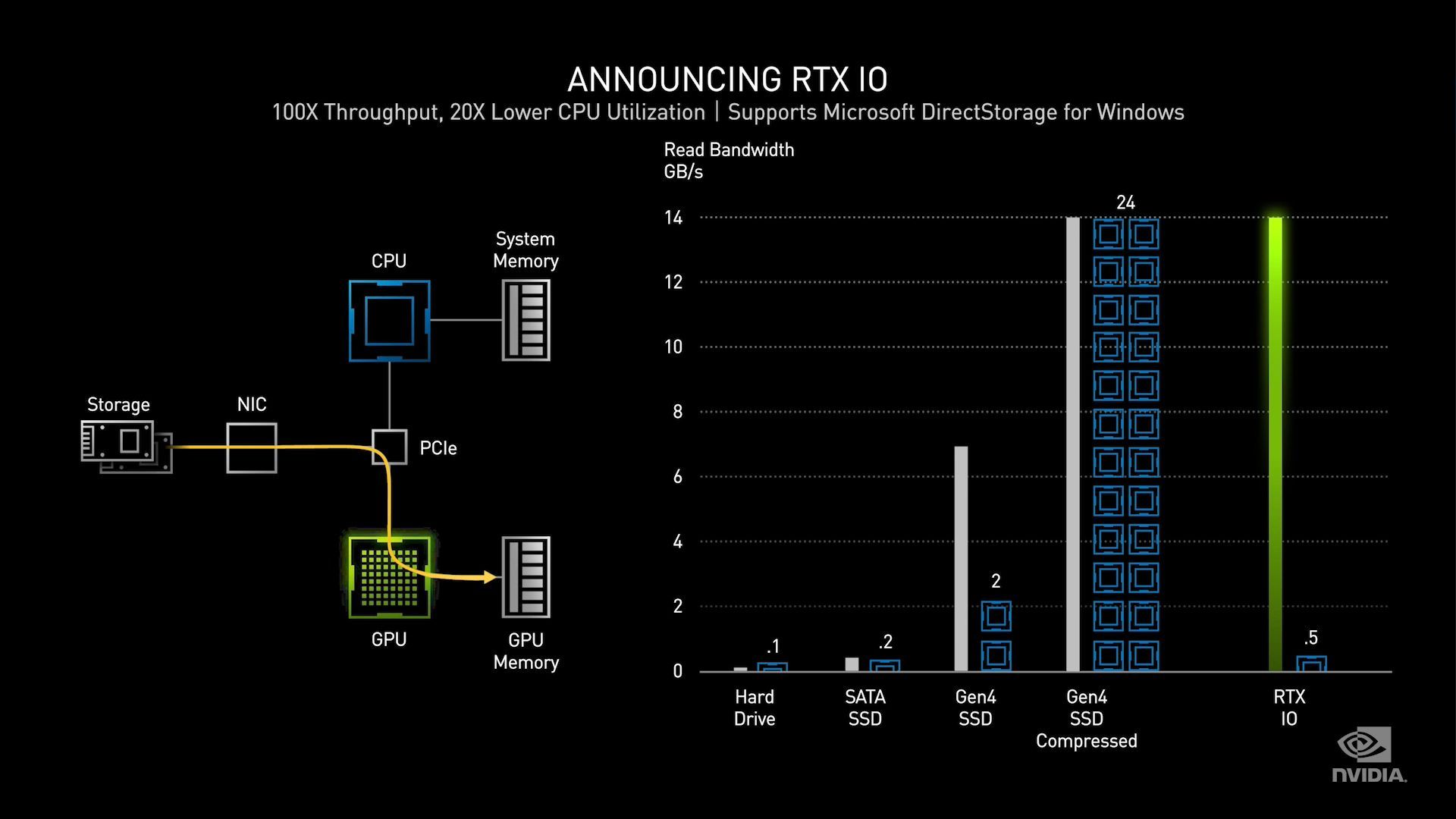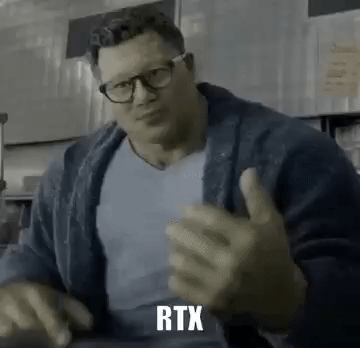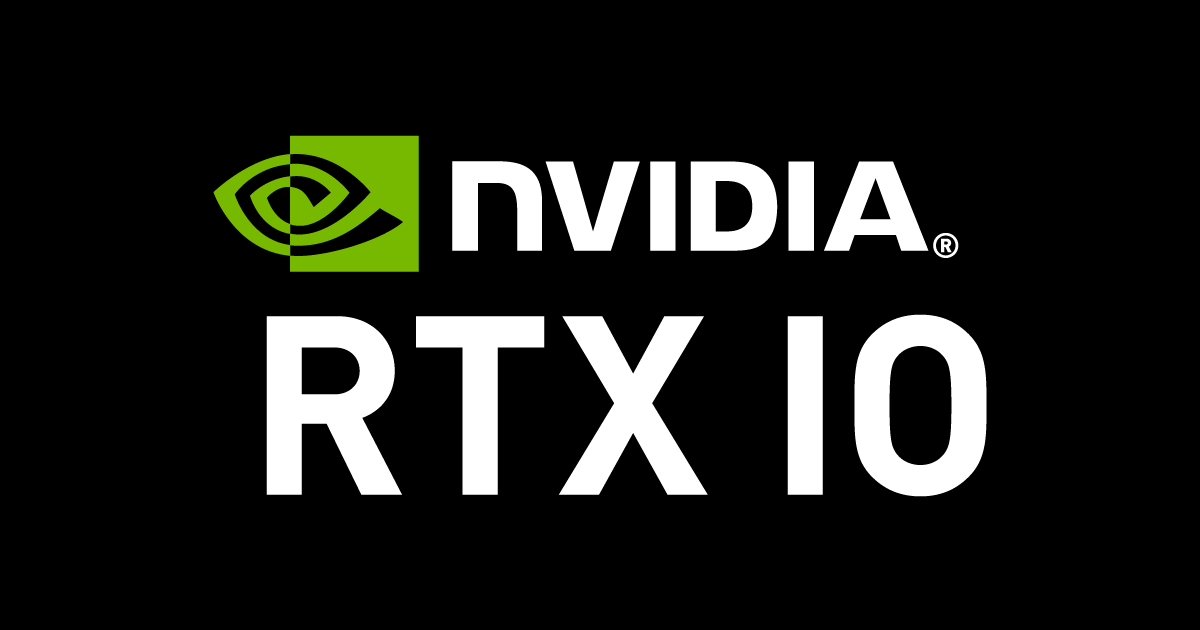What's new with nvidia's approach?
Nothing new. Their decompression implementation looks at least 3x worse than Sony. Probably my /s was too disguised...
What's new with nvidia's approach?
Thank you Mark Cerny.
I honestly wasn't expecting DOUBLE the performance in a single generation like that. But pricing was a mental mind fuck. I can't wait to witness the salt mines from our strongest warriors on this site, that always troll PC based threads.I knew PC hardware would pull ahead fast, but this......Nvidia just buried the consoles from a performance AND pricing standpoint......

Some math:
PC 7GB/sec -> 14GB/sec = 24 Intel cores
Sony 5.5GB/sec-> 22GB/sec = 9 CPU cores
Pretty accurate difference between the skill of Sony and NV software engineers...
Yeah most definitely, go with AMD, they are cheap and powerful, especially now that Zen 3 is closer, Zen2 is getting cheap enough even in high-end.
Well something aint right, what is your components. It's same think as my update with 3900x and Asus X570-E in the beginning of this year.looking on Newegg, with a Ryzen 7 3700 8 core 3.6GHz CPU and everything that goes into it. it'll run me $1200 or so without the 3080. I can probably cut that price down another $300 or so if I use my old power supply and SSDs. might just wait til Black Friday to see if I can get some good deals first.
Note they also mentioned that that there were some similarities in the Raytracing hardware setup to the Xbox.
What is the decompression number for Nvidia I/O? Is it over 14GB/s or something i mixed up?
Actually now people can finally acknowledge that SSD and IO performance DO make a difference.


So do you positively need pcie4.0 for this to work? Some people are saying it will work with 3.0 also and now im confused.

 devblogs.microsoft.com
devblogs.microsoft.com
He makes a lot of bullshit cakes.

Rumor has it, he makes them from salt and tears, which corrodes the plastic away. He needs a bunch of them today, especially.He makes a lot of bullshit cakes.
This is great for the Series X. The more adoption we see for this on the PC side means we'll see more 3rd party games utilize it.
A high tide lifts all boats. Upgrade time ladies and gentlemen
So the fact that nvidia has integrated support of an API that will be used to develop games for PC and series x simultaneously has nothing to do with the series x? Are you sure about that?Collaberate ....
Is that like where you work with someone while yelling at them that they suck?
This has absolutely nothing to do with the Series X, and never will.
Well something aint right, what is your components. It's same think as my update with 3900x and Asus X570-E in the beginning of this year.
So the fact that nvidia has integrated support of an API that will be used to develop games for PC and series x simultaneously has nothing to do with the series x? Are you sure about that?

Alright that WIn 10 buy it here: https://software-codes.com/collections/top-sale/products/windows-10-pro Bam 146USD off.here's what I picked out from Newegg
AMD Ryzen7 3700X 8 core 3.6GHz
$290
ASRock B550M PRO4 MicroATX motherboard
$120
Corsair DDR4 3600 32GB (2 X 16 GB) ram
$115
DIYPC tower case
$90
EVGA 1000W power supply
$200
Intel 1TB QLC SSD
$115
Noctua CPU 140mm fan
$75
Win10 pro 64
$150
Thermal Paste
$8
these comes to around $1163 or so and like I said, just kinda picked them off the store. and I can probably use my old power supply and my SSDs to cut the cost down to $850 or so. adding the $700 of the 3080, that comes to $1550 or so. any better deals out there? I'm not in a hurry hence the mention of Black Friday.
Alright that WIn 10 buy it here: https://software-codes.com/collections/top-sale/products/windows-10-pro Bam 146USD off.
Everything else is understandable, I though you are buying just mobo+CPU+RAM...
Like any leap in fundamental tech. It’s adoption will become increasingly necessary over time.i'm still not sure it's urgent to upgrade
will games really use that tech in the next year ?
i mean most tech from 2XXX is still not really used.

Lol of course they have to follow Ms, they use DirectX.Looking forward to the PS5 regulars now accept the industry is following Microsoft on IO not Sony. That the Microsoft engineers were not liars after all that direct storage was not just PR. So games will be designed around direct storage since the industry is adopting it.
Sony could of worked with amd, intel and nvidia to get their IO the standard. You guys said all the velocity was all pr don't back down now. You guy have 100 pages of trashing it in the official thread. Stand up eat your SSD crow.
It's a retail key by the way so you can put it on more PCs, it's not OEM licence. And they are legit.cool! thanks.
Just NVMe is going to be enough I think : )So, how much these compatible ssd are gonna cost? like a 500 gb model for example?
You don't need a "special" ssd. I'd guess even Gen3 are supported as well. For max throughput you'll need any Gen4 NVMe with a 7GB/s rating.So, how much these compatible ssd are gonna cost? like a 500 gb model for example?
So the fact that nvidia has integrated support of an API that will be used to develop games for PC and series x simultaneously has nothing to do with the series x? Are you sure about that?
I can't tell if I'm interpreting the info correctly, but ...am I right in thinking that RTX IO is a PCIe NIC(network interface card)with a slot for a Gen4 NVMe SSD, that plugs into a new motherboard with PCIe 4.0 bus, and then you need a Nvidia RTX 30 series GPU that also plugs into the PCIe 4.0 bus?
If that is the setup, I assume that the reason PCIe 4 is needed is due to the bi-directional comms between the NIC and GPU will be capable of saturating half the bus at peak transfers, so going up to PCIe 4 leaves enough lanes for a system to still use all the legacy PCIe 3 stuff too without interference.
Even though the numbers look competitive to the XsX XVA and PS5 IO complex, I was surprised that a quick control+F on the nvidia page didn't find the word "latency". From the info provided I would still expect the latency of XVA to be less, maybe 1/2 or a 1/3- because adding a NIC: a switch, and adding external switching increases latency as a general networking rule - and I still expect the IO complex to be 1/5 or less of the latency of the XVA; especially now if this solution is the external design version of the integrated XVA solution.
Ultimately, my main concern for a solution like this, is the number of points of potential trouble shooting when it doesn't perform as expected - and reminds me a little bit of SLI/Crossfire teething troubles and the original 3dfx Voodoo passthru card when you got a blank screen launching a game. A complex multi-component solution like this in the PC space shouts design workaround to me, and it makes me wonder if Nvidia's lack of access to a x86 license to make x86 APUs is now a major problem and a potential for their demise - or acquisition by someone like Intel - in the next 5years.
Even if all those RTX IO numbers work out great, and the latency is on par with the PS5 IO complex - which would be an amazing feat IMO - the RTX IO still looks like a half-way-house solution to me, because the data/memory solution is even more fragmented than before - and questions and potential installation nightmares of if or how the RTX IO SSD can be used as the boot drive for Windows, and if not, what is the gaming performance cost of limitation? - while on the console side, the benefits of unified memory for gaming and the impact on game design is probably about to really take off now that the new consoles have brawny CPUs and heavy weight GPUs to share complex simulations across both types of compute.
But none the less, very interesting new PC tech solution and new exciting times ahead (IMHO).
Yes because the Series X won't have the hardware design to utilize the API. And it's an Nvidia thing not AMD ...

So there goes all the console's supposed edge and superiority. Except those cards will actually be able to process all that data in less that 16ms, MUCH less actually it seems. However that 200GB number looks scary, we were promised lower game sizes due to no duplicated data, but by the looks of it, a 1TB will be able to hold just a few next-gen AAA titles at once :/
I can't tell if I'm interpreting the info correctly, but ...am I right in thinking that RTX IO is a PCIe NIC(network interface card)with a slot for a Gen4 NVMe SSD, that plugs into a new motherboard with PCIe 4.0 bus, and then you need a Nvidia RTX 30 series GPU that also plugs into the PCIe 4.0 bus?
If that is the setup, I assume that the reason PCIe 4 is needed is due to the bi-directional comms between the NIC and GPU will be capable of saturating half the bus at peak transfers, so going up to PCIe 4 leaves enough lanes for a system to still use all the legacy PCIe 3 stuff too without interference.
Even though the numbers look competitive to the XsX XVA and PS5 IO complex, I was surprised that a quick control+F on the nvidia page didn't find the word "latency". From the info provided I would still expect the latency of XVA to be less, maybe 1/2 or a 1/3- because adding a NIC: a switch, and adding external switching increases latency as a general networking rule - and I still expect the IO complex to be 1/5 or less of the latency of the XVA; especially now if this solution is the external design version of the integrated XVA solution.
Ultimately, my main concern for a solution like this, is the number of points of potential trouble shooting when it doesn't perform as expected - and reminds me a little bit of SLI/Crossfire teething troubles and the original 3dfx Voodoo passthru card when you got a blank screen launching a game. A complex multi-component solution like this in the PC space shouts design workaround to me, and it makes me wonder if Nvidia's lack of access to a x86 license to make x86 APUs is now a major problem and a potential for their demise - or acquisition by someone like Intel - in the next 5years.
Even if all those RTX IO numbers work out great, and the latency is on par with the PS5 IO complex - which would be an amazing feat IMO - the RTX IO still looks like a half-way-house solution to me, because the data/memory solution is even more fragmented than before - and questions and potential installation nightmares of if or how the RTX IO SSD can be used as the boot drive for Windows, and if not, what is the gaming performance cost of limitation? - while on the console side, the benefits of unified memory for gaming and the impact on game design is probably about to really take off now that the new consoles have brawny CPUs and heavy weight GPUs to share complex simulations across both types of compute.
But none the less, very interesting new PC tech solution and new exciting times ahead (IMHO).
So since it will work on 2000-series cards, it can't be a physical slot on the video card.RTX IO is supported on all GeForce RTX Turing and NVIDIA Ampere-architecture GPUs.
Some math:
PC 7GB/sec -> 14GB/sec = 24 Intel cores
Sony 5.5GB/sec-> 22GB/sec = 9 CPU cores
Pretty accurate difference between the skill of Sony and NV software engineers...
im really confused i dont know if you're trolling or praising Sony xD
Jesus you are a FUD machine. You gonna spread anymore FUD about Ampere to Turing TF relative performance metrics? There's no way you say what you said in the other thread with a straight face. Puts a lot of your other technical discussions in serious question now.
So far all my "FUD" was on point. On Ampere. I.e. literally all my predictions manifested.
No, you were dead wrong about the IPC gains. You implied 30 TF Ampere was 15 TF Turing. When Ampere is the newer architecture and has (at least) 10% IPC gain over Turing.
Series X huge win.
